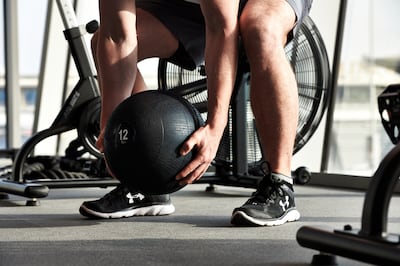During Ramadan, maintaining a normal exercise routine is not easy, especially because of fasting, interrupted sleeping patterns and lowered liquid intake.
However, exercising during the holy month is not only healthy but also helps maintain energy levels, mental clarity and metabolism.
“The 30-day period of fasting can be challenging, and it can be tempting to abandon fitness and health goals,” says Aadil Baksh, a personal trainer at Ultimate Performance Dubai.
“Going long hours without food or water can put a large amount of stress on your body, but with some careful planning and smart training advice, you can still lose weight or build muscle during Ramadan safely and effectively.”
To be prepared for the shift, here are some key things to keep in mind.
Which kind of workout is best during Ramadan?
“When working out during Ramadan, the secret is to stimulate, not annihilate. It’s important to take a more measured approach to your training while fasting,” says Baksh.
As someone who observes the fast himself, Ahmed El Sayed, a personal trainer at Fitness First, says he focuses on three basic aspects in each workout – strength training, cardio and flexibility. “The reason I prioritise muscular strength is because a loss of muscle mass will slow down metabolism. The goal should be to avoid both, losing muscle and a drop in your metabolic rate,” he says.
“When it comes to cardio, I recommend a light-intensity session, limited to 30 minutes of slow, steady distance, every other day. Remember, you will be dehydrated, so your body will use your fat storage as a source of energy, especially if you do cardio before iftar. However, the fact that you’re depleted means your blood pressure might drop at the onset or even after, so don’t skip warm-up and cool-down routines,” says El Sayed.
“Similarly, when you start your resistance training, choose exercises that target the upper body before the lower body to avoid any drop in your blood pressure during or after. The last fitness aspect to focus on is flexibility to avoid any mobility-related issues you might face, especially when you exercise normally again after Ramadan and the Eid break.”
When is the best time to work out during Ramadan?
Given the mid-day sun and no liquids from sunrise to sunset, you will compromise your health by pushing yourself too much. It is not recommended to do intense cardio workouts and heavy weight-training exercises while fasting. You should also cut your routine down to two cardio sessions a week throughout the holy month.
Baksh recommends exercising in the early morning; however, if that doesn't work, he suggests after iftar.
“Training early in the morning is best during Ramadan after your first meal of the day,” he says. “If this doesn’t work with your schedule, then hit the gym after your first main meal after iftar, so your body is well fuelled and has the right nutrients for optimal recovery.”
Dr Mona Mobarak, a clinical nutritionist, adds that exercising in a fasted state is no easy task, but it is important to find the best time to ensure a routine is safe and sustainable.
“I would suggest doing strength training routines pre-iftar, but if you prefer to exercise after iftar, try to keep your meal light and save your biggest meal for after your session so you don't feel uncomfortable when training,” she says.
Mobarak also suggests cutting down the time of usual workouts by 15 minutes to limit stress on the body. So, if you usually work out for 60 minutes, limit yourself to 45 minutes instead.
“Don’t feel you have to spend hours in the gym for an effective workout session,” Baksh adds. “You can get a lot done in 45 minutes if you train hard and with intensity. If your long-term goal is building muscle, an option during Ramadan could be to lower the load and add more sets to maintain muscle mass.”
El Sayed suggests routines based on the time of day when working out during Ramadan:
Before iftar
A light workout during the cooler part of the day means you can soon replenish yourself with water, and reap the benefits of exercising on an empty stomach. However, any workout done at this time should be low-key with more resistance training, low repetitions and weights, and plenty of stretching. This is also a good time for a short brisk walk or light jog.
Right after iftar
While cardio can be difficult on a full stomach, an hour after iftar is a good time for weight training. On the days you plan to exercise after your meal, add in a little extra food to fuel your body and ensure you drink plenty of water to rehydrate.
After iftar, but before late night
For night owls, the best time to work out may be between 11pm and 2am, after your food has had time to settle and your body has fully rehydrated. If you have managed to get some rest in the afternoon, exercising at this time can be favourable, as it is cooler than the daytime, and will still leave you with a few hours of sleep before you wake up to start the day.
Suhoor
For early risers, the best time to work out may be before your suhoor. This way, you will have energy from the previous night's meal, yet be on an empty stomach. You can hydrate while you exercise and once you are done, eat again to refuel. This method will also get you energised for the day ahead.
Jetour T1 specs
Engine: 2-litre turbocharged
Power: 254hp
Torque: 390Nm
Price: From Dh126,000
Available: Now
Living in...
This article is part of a guide on where to live in the UAE. Our reporters will profile some of the country’s most desirable districts, provide an estimate of rental prices and introduce you to some of the residents who call each area home.
Paatal Lok season two
Directors: Avinash Arun, Prosit Roy
Stars: Jaideep Ahlawat, Ishwak Singh, Lc Sekhose, Merenla Imsong
Rating: 4.5/5
Stan%20Lee
%3Cp%3E%3Cstrong%3EDirector%3A%3C%2Fstrong%3E%20David%20Gelb%3C%2Fp%3E%0A%3Cp%3E%3Cstrong%3ERating%3A%3C%2Fstrong%3E%203%2F5%3C%2Fp%3E%0A
THE SPECS
Engine: 3.6-litre V6
Transmission: eight-speed automatic
Power: 285bhp
Torque: 353Nm
Price: TBA
On sale: Q2, 2020
UAE%20Warriors%2045%20Results
%3Cp%3E%3Cstrong%3E%0DMain%20Event%0D%3A%20Lightweight%20Title%3C%2Fstrong%3E%0D%3Cbr%3EAmru%20Magomedov%20def%20Jakhongir%20Jumaev%20-%20Round%201%20(submission)%0D%3Cbr%3E%3Cstrong%3ECo-Main%20Event%0D%3A%20Bantamweight%3C%2Fstrong%3E%0D%3Cbr%3ERany%20Saadeh%20def%20Genil%20Franciso%20-%20Round%202%20(submission)%0D%3Cbr%3E%3Cstrong%3ECatchweight%20150%20lbs%3C%2Fstrong%3E%0D%3Cbr%3EWalter%20Cogliandro%20def%20Ali%20Al%20Qaisi%20-%20Round%201%20(TKO)%0D%3Cbr%3E%3Cstrong%3EBantamweight%3C%2Fstrong%3E%0D%3Cbr%3ERenat%20Khavalov%20def%20Hikaru%20Yoshino%20-%20Round%202%20(TKO)%0D%3Cbr%3E%3Cstrong%3EFlyweight%3C%2Fstrong%3E%0D%3Cbr%3EVictor%20Nunes%20def%20Nawras%20Abzakh%20-%20Round%201%20(TKO)%0D%3Cbr%3E%3Cstrong%3EFlyweight%3C%2Fstrong%3E%0D%3Cbr%3EYamato%20Fujita%20def%20Sanzhar%20Adilov%20-%20Round%201%20(submission)%0D%3Cbr%3E%3Cstrong%3ELightweight%3C%2Fstrong%3E%0D%3Cbr%3EAbdullo%20Khodzhaev%20def%20Petru%20Buzdugen%20-%20Round%201%20(TKO)%0D%3Cbr%3E%3Cstrong%3ECatchweight%20139%20lbs%3C%2Fstrong%3E%0D%3Cbr%3ERazhabali%20Shaydullaev%20def%20Magomed%20Al-Abdullah%20-%20Round%202%20(submission)%0D%3Cbr%3E%3Cstrong%3EFlyweight%3C%2Fstrong%3E%0D%3Cbr%3ECong%20Wang%20def%20Amena%20Hadaya%20-%20Points%20(unanimous%20decision)%0D%3Cbr%3E%3Cstrong%3EMiddleweight%3C%2Fstrong%3E%0D%3Cbr%3EKhabib%20Nabiev%20def%20Adis%20Taalaybek%20Uulu%20-%20Round%202%20(submission)%0D%3Cbr%3E%3Cstrong%3ELight%20Heavyweight%3C%2Fstrong%3E%0D%3Cbr%3EBartosz%20Szewczyk%20def%20Artem%20Zemlyakov%20-%20Round%202%20(TKO)%3C%2Fp%3E%0A
Key recommendations
- Fewer criminals put behind bars and more to serve sentences in the community, with short sentences scrapped and many inmates released earlier.
- Greater use of curfews and exclusion zones to deliver tougher supervision than ever on criminals.
- Explore wider powers for judges to punish offenders by blocking them from attending football matches, banning them from driving or travelling abroad through an expansion of ‘ancillary orders’.
- More Intensive Supervision Courts to tackle the root causes of crime such as alcohol and drug abuse – forcing repeat offenders to take part in tough treatment programmes or face prison.
The burning issue
The internal combustion engine is facing a watershed moment – major manufacturer Volvo is to stop producing petroleum-powered vehicles by 2021 and countries in Europe, including the UK, have vowed to ban their sale before 2040. The National takes a look at the story of one of the most successful technologies of the last 100 years and how it has impacted life in the UAE.
Read part four: an affection for classic cars lives on
Read part three: the age of the electric vehicle begins
Read part one: how cars came to the UAE
Various Artists
Habibi Funk: An Eclectic Selection Of Music From The Arab World (Habibi Funk)
The candidates
Dr Ayham Ammora, scientist and business executive
Ali Azeem, business leader
Tony Booth, professor of education
Lord Browne, former BP chief executive
Dr Mohamed El-Erian, economist
Professor Wyn Evans, astrophysicist
Dr Mark Mann, scientist
Gina MIller, anti-Brexit campaigner
Lord Smith, former Cabinet minister
Sandi Toksvig, broadcaster
Timeline
2012-2015
The company offers payments/bribes to win key contracts in the Middle East
May 2017
The UK SFO officially opens investigation into Petrofac’s use of agents, corruption, and potential bribery to secure contracts
September 2021
Petrofac pleads guilty to seven counts of failing to prevent bribery under the UK Bribery Act
October 2021
Court fines Petrofac £77 million for bribery. Former executive receives a two-year suspended sentence
December 2024
Petrofac enters into comprehensive restructuring to strengthen the financial position of the group
May 2025
The High Court of England and Wales approves the company’s restructuring plan
July 2025
The Court of Appeal issues a judgment challenging parts of the restructuring plan
August 2025
Petrofac issues a business update to execute the restructuring and confirms it will appeal the Court of Appeal decision
October 2025
Petrofac loses a major TenneT offshore wind contract worth €13 billion. Holding company files for administration in the UK. Petrofac delisted from the London Stock Exchange
November 2025
180 Petrofac employees laid off in the UAE
Who's who in Yemen conflict
Houthis: Iran-backed rebels who occupy Sanaa and run unrecognised government
Yemeni government: Exiled government in Aden led by eight-member Presidential Leadership Council
Southern Transitional Council: Faction in Yemeni government that seeks autonomy for the south
Habrish 'rebels': Tribal-backed forces feuding with STC over control of oil in government territory
UAE currency: the story behind the money in your pockets
US%20federal%20gun%20reform%20since%20Sandy%20Hook
%3Cp%3E-%20April%2017%2C%202013%3A%20A%20bipartisan-drafted%20bill%20to%20expand%20background%20checks%20and%20ban%20assault%20weapons%20fails%20in%20the%20Senate.%3C%2Fp%3E%0A%3Cp%3E-%20July%202015%3A%20Bill%20to%20require%20background%20checks%20for%20all%20gun%20sales%20is%20introduced%20in%20House%20of%20Representatives.%20It%20is%20not%20brought%20to%20a%20vote.%3C%2Fp%3E%0A%3Cp%3E-%20June%2012%2C%202016%3A%20Orlando%20shooting.%20Barack%20Obama%20calls%20on%20Congress%20to%20renew%20law%20prohibiting%20sale%20of%20assault-style%20weapons%20and%20high-capacity%20magazines.%3C%2Fp%3E%0A%3Cp%3E-%20October%201%2C%202017%3A%20Las%20Vegas%20shooting.%20US%20lawmakers%20call%20for%20banning%20bump-fire%20stocks%2C%20and%20some%20renew%20call%20for%20assault%20weapons%20ban.%3C%2Fp%3E%0A%3Cp%3E-%20February%2014%2C%202018%3A%20Seventeen%20pupils%20are%20killed%20and%2017%20are%20wounded%20during%20a%20mass%20shooting%20in%20Parkland%2C%20Florida.%3C%2Fp%3E%0A%3Cp%3E-%20December%2018%2C%202018%3A%20Donald%20Trump%20announces%20a%20ban%20on%20bump-fire%20stocks.%3C%2Fp%3E%0A%3Cp%3E-%20August%202019%3A%20US%20House%20passes%20law%20expanding%20background%20checks.%20It%20is%20not%20brought%20to%20a%20vote%20in%20the%20Senate.%3C%2Fp%3E%0A%3Cp%3E-%20April%2011%2C%202022%3A%20Joe%20Biden%20announces%20measures%20to%20crack%20down%20on%20hard-to-trace%20'ghost%20guns'.%3C%2Fp%3E%0A%3Cp%3E-%20May%2024%2C%202022%3A%20Nineteen%20children%20and%20two%20teachers%20are%20killed%20at%20an%20elementary%20school%20in%20Uvalde%2C%20Texas.%3C%2Fp%3E%0A%3Cp%3E-%20June%2025%2C%202022%3A%20Joe%20Biden%20signs%20into%20law%20the%20first%20federal%20gun-control%20bill%20in%20decades.%3C%2Fp%3E%0A
GRAN%20TURISMO
%3Cp%3E%3Cstrong%3EDirector%3A%3C%2Fstrong%3E%20Neill%20Blomkamp%3C%2Fp%3E%0A%3Cp%3E%3Cstrong%3EStars%3A%3C%2Fstrong%3E%20David%20Harbour%2C%20Orlando%20Bloom%2C%20Archie%20Madekwe%2C%20Darren%20Barnet%3C%2Fp%3E%0A%3Cp%3E%3Cstrong%3ERating%3A%3C%2Fstrong%3E%203%2F5%3C%2Fp%3E%0A
GAC GS8 Specs
Engine: 2.0-litre 4cyl turbo
Power: 248hp at 5,200rpm
Torque: 400Nm at 1,750-4,000rpm
Transmission: 8-speed auto
Fuel consumption: 9.1L/100km
On sale: Now
Price: From Dh149,900
Company%20profile
%3Cp%3EName%3A%20Tabby%3Cbr%3EFounded%3A%20August%202019%3B%20platform%20went%20live%20in%20February%202020%3Cbr%3EFounder%2FCEO%3A%20Hosam%20Arab%2C%20co-founder%3A%20Daniil%20Barkalov%3Cbr%3EBased%3A%20Dubai%2C%20UAE%3Cbr%3ESector%3A%20Payments%3Cbr%3ESize%3A%2040-50%20employees%3Cbr%3EStage%3A%20Series%20A%3Cbr%3EInvestors%3A%20Arbor%20Ventures%2C%20Mubadala%20Capital%2C%20Wamda%20Capital%2C%20STV%2C%20Raed%20Ventures%2C%20Global%20Founders%20Capital%2C%20JIMCO%2C%20Global%20Ventures%2C%20Venture%20Souq%2C%20Outliers%20VC%2C%20MSA%20Capital%2C%20HOF%20and%20AB%20Accelerator.%3Cbr%3E%3C%2Fp%3E%0A
Why it pays to compare
A comparison of sending Dh20,000 from the UAE using two different routes at the same time - the first direct from a UAE bank to a bank in Germany, and the second from the same UAE bank via an online platform to Germany - found key differences in cost and speed. The transfers were both initiated on January 30.
Route 1: bank transfer
The UAE bank charged Dh152.25 for the Dh20,000 transfer. On top of that, their exchange rate margin added a difference of around Dh415, compared with the mid-market rate.
Total cost: Dh567.25 - around 2.9 per cent of the total amount
Total received: €4,670.30
Route 2: online platform
The UAE bank’s charge for sending Dh20,000 to a UK dirham-denominated account was Dh2.10. The exchange rate margin cost was Dh60, plus a Dh12 fee.
Total cost: Dh74.10, around 0.4 per cent of the transaction
Total received: €4,756
The UAE bank transfer was far quicker – around two to three working days, while the online platform took around four to five days, but was considerably cheaper. In the online platform transfer, the funds were also exposed to currency risk during the period it took for them to arrive.
THE DETAILS
Kaala
Dir: Pa. Ranjith
Starring: Rajinikanth, Huma Qureshi, Easwari Rao, Nana Patekar
Rating: 1.5/5




